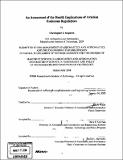| dc.contributor.advisor | Ian A. Waitz. | en_US |
| dc.contributor.author | Sequeira, Christopher J | en_US |
| dc.contributor.other | Massachusetts Institute of Technology. Technology and Policy Program. | en_US |
| dc.date.accessioned | 2008-11-07T19:00:20Z | |
| dc.date.available | 2008-11-07T19:00:20Z | |
| dc.date.copyright | 2008 | en_US |
| dc.date.issued | 2008 | en_US |
| dc.identifier.uri | http://hdl.handle.net/1721.1/43084 | |
| dc.description | Thesis (S.M.)--Massachusetts Institute of Technology, Dept. of Aeronautics and Astronautics; and, (S.M.)--Massachusetts Institute of Technology, Engineering Systems Division, Technology and Policy Program, 2008. | en_US |
| dc.description | Includes bibliographical references (p. 121-129). | en_US |
| dc.description.abstract | An exploration of the health implications of aviation emissions regulations is made by assessing the results of a study of aviation's effects on United States air quality mandated by the Energy Policy Act of 2005. The Energy Policy Act study results estimated that aviation is responsible for 160 yearly incidences (with a 90% confidence interval of 64 to 270 incidences) of premature mortality of adults age 30 and over ($882 million in year 2001 dollars, with a 91% CI of $196 to $1830 million) due to exposure to particulate matter below 2.5 /im in size (PM2.5) in the continental U.S. as reported by the Environmental Benefits Mapping and Analysis Program (BenMAP). Strong regional differences were noted; for instance, 18% of the total health incidences and costs occurred in Los Angeles County. Aviation was estimated to decrease ozone concentrations, causing small premature mortality disbenefits (health effects avoided due to the presence of aviation) of approximately 2 yearly premature mortality incidences ($9 million). Primary particulate matter values in the Energy Policy Act study's emissions inventory had been generated using a conservatively biased version of the First Order Approximation method version 3.0 (FOA3), known as FOA3a, and the emissions of sulfur oxides (SOx) had been incorrectly computed (underestimated by approximately 15%). To quantify the effects of these differences on health impacts, a comparison was made with a second inventory generated by CSSI, Inc. using FOA3. Based on the comparison, it is estimated that aviation was responsible for 140 to 160 yearly incidences of premature mortality from exposure to PM. 46% to 69% of the incidences were estimated to be due to changes in concentrations of ammonium sulfate secondary PM from SOx, while ammonium nitrate secondary PM was estimated to be responsible for 18% to 20%. | en_US |
| dc.description.abstract | (cont.) Concentrations of volatile primary PM from organic compounds and nonvolatile primary PM were responsible for 6% - 18% and 5% - 14% of the impact, respectively, while volatile primary PM from sulfates was responsible for 0% to 4%. Confidence intervals were not computed, and only the effects of changes in PM concentrations were assessed. Based on the results, it is determined that changing regulations governing nitrogen oxide (NOx) emissions and fuel sulfur content may be effective strategies to mitigate incidences of premature mortality due to aviation. An assessment was made of the effects of changing fuel sulfur concentration from 600 parts per million (ppm), as is typical of current jet fuel, to 15 ppm across the continental U.S. It is estimated that this change would reduce yearly premature mortality incidences due to aviation-related ambient PM exposure by 38%. Confidence intervals were not computed. The cumulative additional costs to refineries to produce 15-ppm fuel could be approximately $260 million, suggesting that the benefits may be comparable to the costs. However, such a strategy could have climate warming impacts since aviation sulfur emissions have a cooling influence on climate. It is also estimated that an immediate deployment of ultra-low sulfur fuel only for takeoffs from Los Angeles County could reduce aviation-related nationwide yearly incidences of mortality by 10%, with Los Angeles County health impacts bring reduced by a factor of 2. The additional costs to refineries may be approximately $12 million, suggesting that such a policy may be cost-beneficial. Finally, a brief exploration is done of a NOx stringency assessment by the International Civil Aviation Organization's Forecasting and Economic Analysis Support Group (FESG), which predicted that an industry-wide investment of $30,000 - $40,000 would be required for every tonne of NOx eliminated if the ICAO NOx standard were to be increased by 10% in the year 2008. | en_US |
| dc.description.abstract | (cont.) FESG found this to be the most cost-effective NO, reduction strategy. A direct comparison with the Energy Policy Act and RSM results is difficult, yet an assessment finds that NO, has health costs of only $2,000 per tonne in both sets of results. | en_US |
| dc.description.statementofresponsibility | by Christopher J. Sequeira. | en_US |
| dc.format.extent | 135 p. | en_US |
| dc.language.iso | eng | en_US |
| dc.publisher | Massachusetts Institute of Technology | en_US |
| dc.rights | M.I.T. theses are protected by
copyright. They may be viewed from this source for any purpose, but
reproduction or distribution in any format is prohibited without written
permission. See provided URL for inquiries about permission. | en_US |
| dc.rights.uri | http://dspace.mit.edu/handle/1721.1/7582 | en_US |
| dc.subject | Aeronautics and Astronautics. | en_US |
| dc.subject | Technology and Policy Program. | en_US |
| dc.title | An assessment of the health implications of aviation emissions regulations | en_US |
| dc.type | Thesis | en_US |
| dc.description.degree | S.M. | en_US |
| dc.contributor.department | Massachusetts Institute of Technology. Department of Aeronautics and Astronautics | |
| dc.contributor.department | Massachusetts Institute of Technology. Engineering Systems Division | |
| dc.contributor.department | Technology and Policy Program | |
| dc.identifier.oclc | 244387792 | en_US |

